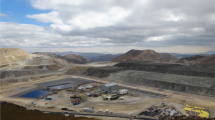Abstract
The aim of this study was to investigate the change of Pu oxidation states due to interaction with aerobic bacteria and fungi at low pH under laboratory conditions. Microorganisms were isolated from samples collected from the low-level radioactive waste repository within the confines of Ignalina NPP. Abilities of the fungi (Absidia spinosa var spinosa Lendn. and Paecilomyces lilacinus Thom Samson) as well as Gram-positive bacteria (Bacillus mycoides and Micrococcus luteus) and Gram-negative bacterium I-m1 to transform the oxidation states of Pu under aerobic conditions were investigated. Oxidized and reduced Pu was tested using two radiochemical procedures. The amount of reduced and oxidized Pu was determined by measuring alpha activity after radiochemical separation. The results have shown that all bacteria and fungi can very slightly alter oxidation states of Pu due to their microbial activity. All the microorganisms tested demonstrate quite a fast process of Pu biosorption under the experimental conditions.


Similar content being viewed by others
References
Brainard JR, Strietelmeier BA, Smith PH, Langston-Unkefer PJ, Barr ME, Ryan RR (1992) Radiochim Acta 58–59:357–363
John SG, Ruggiero CE, Hersman LE, Tung CS, Neu MP (2001) Environ Sci Technol 35:2942–2948
Francis AJ (2001) In: Kudo A (ed) Plutonium in environment. Elsevier, Amsterdam
Francis AJ, Dodge CJ, Ohnuki T (2007) J Nucl Radiochem Sci 8:121–127
Panak PJ, Nitsche H (2001) Radiochim Acta 89:499–504
Kakiuchi H, Amano H, Ichimasa M (2002) J Radioanal Nucl Chem 252(2):437–439
Ohnuki T, Samadfam M, YoshidaT, Ozaki T, Yoshida Z, Francis AJ (2003) In: Jarvinen GD (ed) Plutonium futures—the science. American Institute of Physics, Melville, New York
Panak PJ, Booth CH, Caulder DL, Bucher JJ, Shuh DK, Nitsche H (2002) Radiochim Acta 90:315–321
Neu MP, Icopini GA, Boukhalfa H (2005) Radiochim Acta 93:705–714
Wang J, Chem C (2009) Biotechnol Adv 27:195–226
Roussel-Debet S, Deneux-Mustin S, Munier-Lamy C (2005) Radioprotection 40(1):587–591
German KE, Firsova EV, Peretrukhin VF, Khizhnyak TV, Simonoff M (2003) Radiochemistry 45(3):250–256
Mohapatra BR, Dinardo O, Gould WD, Koren DW (2010) Miner Eng 23:591–599
Francis AJ (2007) J Alloys Compd 444–445:500–505
Veglio F, Beolchini F (1997) Hydrometallurgy 44:301–316
Nakajima A, Tsuruta T (2004) J Radioanal Nucl Chem 260:13–18
Golab Z, Orlowska B, Smith RW (1991) Water Air Soil Pollut 60:99
Andres Y, Maccordick HJ, Hubert J-C (1993) Appl Microbiol Biotechnol 39:413
White C, Gads GM (1990) J Chem Technol Biotechnol 49:331
Levinskaitė L, Smirnov A, Lukšienė B, Druteikienė R, Remeikis V, Baltrūnas D (2009) Nukleonika 54:285
Ekberg SA, Palmer PD, Newton TW, Clark DL (1994) Environ Sci Technol 28:1686–1690
Icopini GA, Lack JG, Hersman LE, Neu MP, Boukahalfa H (2009) Appl Environ Microbiol 75(11):3641–3647
Rusin PA, Quintana L, Brainard JR, Strietelmeier BA, Tait CD, Ekberg SA, Palmer PD, Newton TW, Clark DL (1994) Environ Sci Technol 28:1686
Holt JC, Bergey DH (1994) Bergey’s manual of determinative bacteriology, 9th edn. Williams and Wilkins, Baltimore
Gilman LC (1966) A manual of soil fungi. The Iowa State University Press, Ames, Iowa
Barnet HL (1967) Illustrated genera of imperfect fungi. Princeton University Press, Princeton
Barron GL (1968) The genera of hyphomycetes from the soil. The Williams and Wilkins Co, Baltimore
Ellis MB (1971) Dematiaceous hyphomycetes. Kew, Surrey, England: Commonwealth mycological Institute. Reprinted by Aberystwyth, Dyfed, U.K. Cambrian Printers
Domsch KH, Gams W, Anderson TH (1980) Compendium of soil fungi. Academic Press, New York
Kiffer E, Morelet M (1999) The deuteromycetes: mitosporic fungi. Classification and generic keys. Science Publishers Inc., USA
Watanabe T (2000) Pictorial atlas of soil and seed fungi: morphologies of cultural fungi and key to species, 2nd edn. CRC Press, Boca Raton
Williams ST, Sharpe ME (1989) In: Holt JG (ed) Bergey’s manual of systematic bacteriology, vol 4. Lippincott Williams and Wilkins Company, Baltimore
Pitt JI (1979) The genus Penicillium and its teliomorphic states Eupenicillium and Talaromyces. Academic Press, New York
Yun JI, Cho HR, Neck V, Altmaier M, Seibert A, Marquardt CM, Walther C, Fanghanel Th (2007) Radiochim Acta 95:89
Lovett MB, Nelson DM (1981) Techniques for identifying transuranic speciation in aquatic environments. IAEA, Vienna
Talvitie NA (1971) Anal Chem 43:1827
Kleinkauf H, von Dohren H, Dornauer H, Nesemann G (1986) Regulation of secondary metabolite formation. VCH, Weinheim
Lovley DR (1993) Annu Rev Microbiol 47:263–290
Lovley DR, Phillips EJP, Gorby YA, Landa ER (1991) Nature (Lond) 350:413–416
Turick CE (2001) The physiological role and characterization of melanin produced by Shewanella algae BrY. Doctoral Dissertation, University of Hampshire, Durham, NC
Acknowledgments
The research leading to these results has received funding from the European Atomic Energy Community Seventh Framework Programme [FP7/2007-2013] under grant agreement no. 212287, Collaborative Project Recosy.
Author information
Authors and Affiliations
Corresponding author
Rights and permissions
About this article
Cite this article
Druteikienė, R., Lukšienė, B., Pečiulytė, D. et al. Interaction of biomass of aerobic bacteria and fungi with Pu(IV) at low pH. J Radioanal Nucl Chem 286, 387–391 (2010). https://doi.org/10.1007/s10967-010-0824-x
Received:
Published:
Issue Date:
DOI: https://doi.org/10.1007/s10967-010-0824-x




